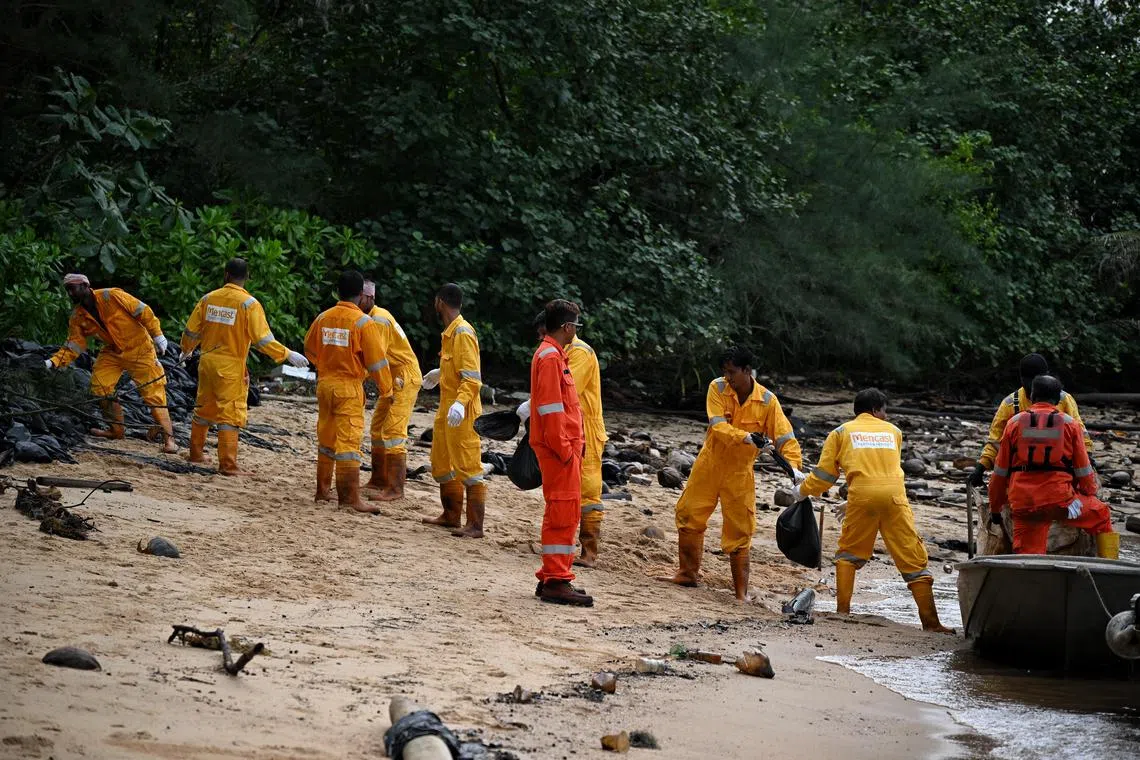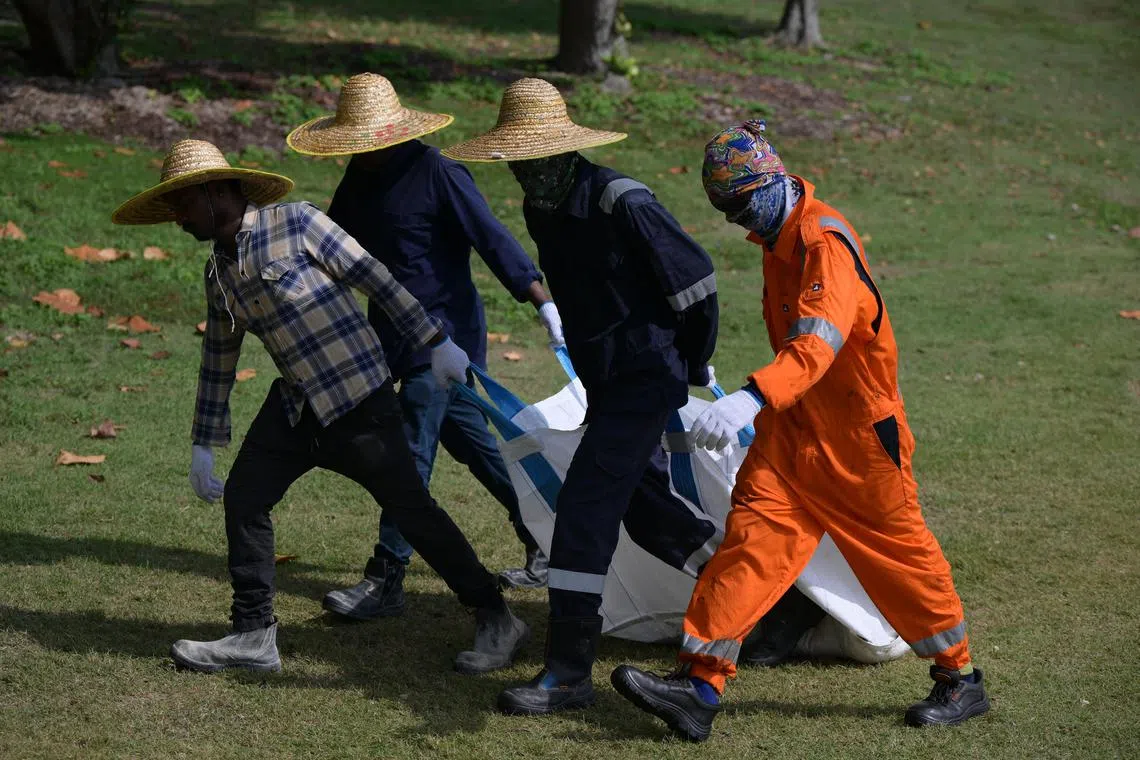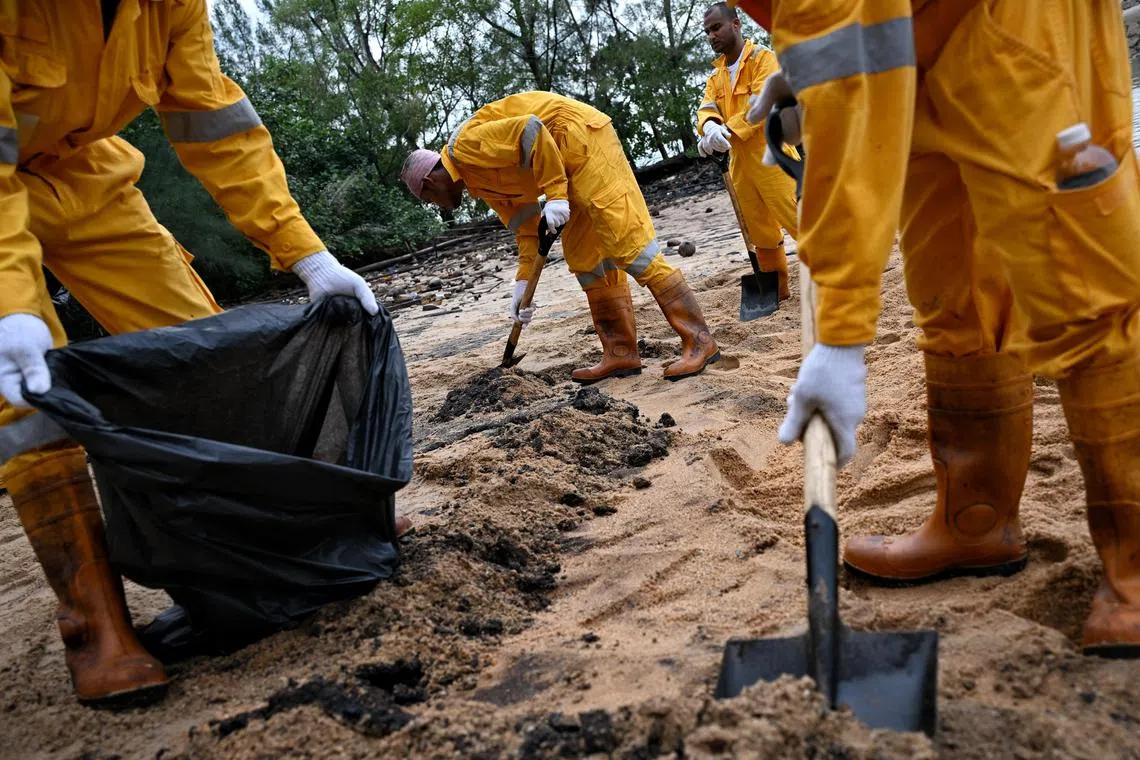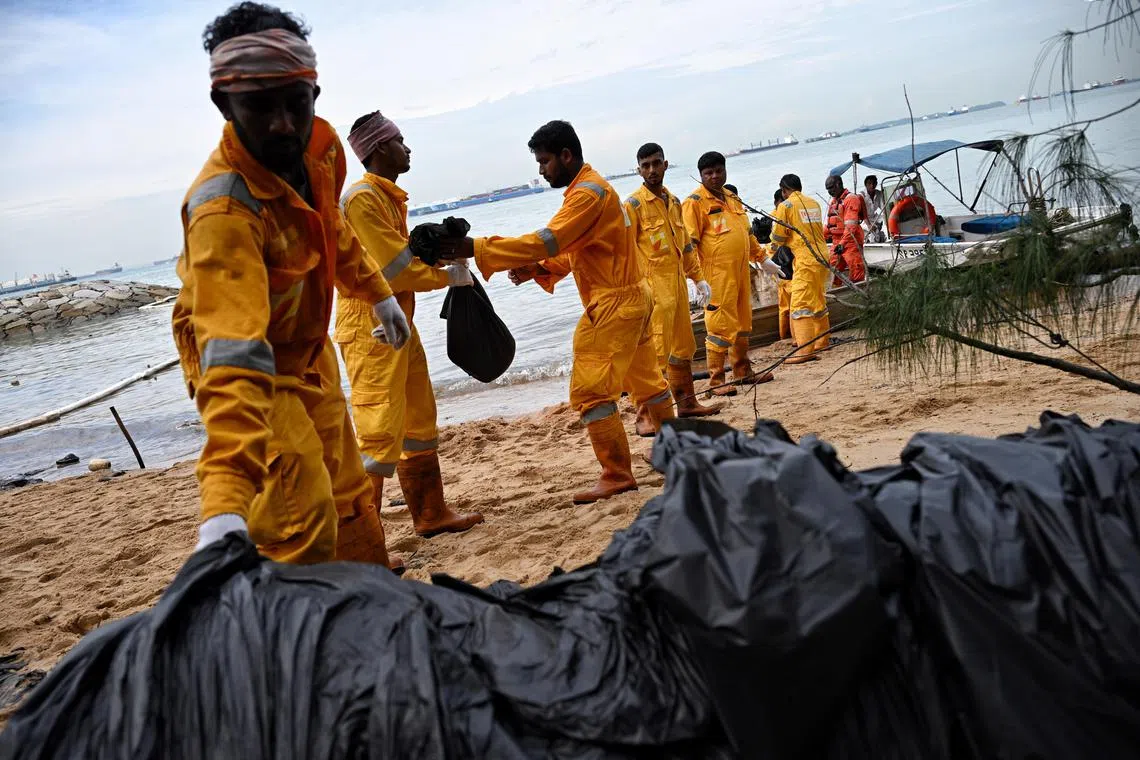Cleaning up after the oil spill: Unsung heroes in Singapore toil daily for over 2 months
Sign up now: Get ST's newsletters delivered to your inbox

When the tide comes in at East Coast Park, workers form a human chain to load the boat with bags of oil-stained sand, which brings it back to a staging area.
ST PHOTO: KUA CHEE SIONG
Follow topic:
SINGAPORE – Twelve hours a day, seven days a week, for the past two months.
This is how hard Mr Ramdzan Salim and hundreds of others have worked to wash and scrub, and scoop the oil from Singapore’s waters and beaches after the Republic’s worst oil spill in a decade.
Mr Ramdzan, a site supervisor with salvage firm Resolve Marine, got up at dawn every day to lead his team in cleaning fish farm sea cages between Lazarus and St John’s islands, as well as Kusu Island.
The 52-year-old used to stay up till midnight after returning home from work. But for the past two months, Mr Ramdzan was physically worn out and did not enjoy any free time, falling asleep after the day’s work by 9pm. As a result, he did not talk to his sons face to face in this entire period.
He was among the many involved in the extensive clean-up operations that kicked in after 400 tonnes of oil leaked into Singapore’s waters when a dredging boat hit a stationary bunker vessel on June 14.
Thanks to the sweat and efforts of hundreds of migrant workers and contractors, some affected areas have already reopened, including East Coast Park’s beaches Sentosa’s Siloso Beach
At least 1,000 workers have been involved so far in cleaning up the beaches.
The Straits Times speaks to workers in the thick of clean-up operations at various locations.
Southern Islands
Over at the Southern Islands, which include St John’s, Lazarus and Kusu islands, some 60 workers contracted by Resolve Marine had been removing oil-stained sand from the beaches, washing rock bunds and scrubbing fish farm sea cages by hand since June 20.
In charge of guiding a team of 12 to clean 12 large and 15 small sea cages, Mr Ramdzan hand-picked workers with basic swimming skills at the start of each day.
This was important as workers needed to use steel wool to scrub the outer and inner surfaces of the sea cages, and a high-pressure water jet to wash the oil off, all while balancing on the wobbly platforms amid strong currents.

Mr Ramdzan Salim steering a boat that is also used to ferry workers to and from the sea cages, and for evacuation when it rained heavily.
ST PHOTO: NG SOR LUAN
“And then there are workers who are not used to being so close to the water, so they get seasick, almost puking, even,” said Mr Ramdzan, adding that a few of them fell off the platforms.
They were also exposed to lightning risk, he added, as the nearest shelter could be 30m to 250m away from the sea cages, and accessible only by boat.
That posed another challenge as the team had only one “getaway” boat – the same small boat with the high-pressure water jet pump.
On average, workers needed about 1½ days to clean one sea cage.
It did not get easier back on land, with unwelcome beach visitors interrupting the clean-up progress at Lazarus Island.

As forklifts could not enter the beach on St John’s Island, workers had to pull jumbo bags of tar balls across the beach and uphill to the nearest possible access point on solid ground.
ST PHOTO: NG SOR LUAN
Resolve Marine site supervisor Ahmad Qamarul, 36, who was tasked with driving a forklift, said a one-way trip from the beach to the disposal barge during weekends could take up to an hour – as visitors also use the narrow pathway – instead of the usual 10 minutes.
While lamenting that the clean-up works have been exhausting, Resolve Marine site supervisor Zaki Zazali, 36, quipped: “We tried to make the best of it. If we visit Kusu Island in our free time, we have to pay for the ferry ride, but we got to go there every day for free because of this.”
Sentosa’s beaches
On Sentosa, the cleaning of breakwaters – offshore stone walls built to protect beaches from the force of waves – is challenging as small, specialised boats are needed to navigate the shallow waters there.
Small-boat operator Kairos Boats founder Roy Soeigiarto has been in charge of taking about 100 workers to and from each breakwater and monitoring their safety at sea since June 18.
The work is very tedious and it takes them half a day to finish flushing only a metre’s worth of rock crevices with high-pressure water jets, he said.

Workers have to clean oil from the crevices and cracks in breakwaters using high-pressure water jets. This requires them to hose the rocks from awkward and dangerous angles, which may potentially cause them to fall.
ST PHOTO: KELVIN CHNG
“The workers do it literally inch by inch, bit by bit,” the 53-year-old said, adding that the entire process requires workers to flush the rock crevices and hose down the entire area before using absorbent pads to pick up the residual oil.
Among them is Mr Asadu Zzaman Anwar, 30, who left Bangladesh for Singapore two months ago to join the clean-up operations as a general worker contracted by marine logistics firm SG Shipping.
While it can get quite warm wearing a full-body protective suit under the sun, Mr Anwar said that the open-air environment helps to cool him down and described the work as relatively “comfortable”.

(From left) Mr Asadu Zzaman Anwar, a general worker involved in the high-pressure water jet spraying of the breakwaters; Mr Kalimuthu Rajiv Ganthi, a cargo buggy driver ferrying logistics between sites, and Mr Satya Prakash, a technical supervisor in charge of fixing faulty equipment.
ST PHOTO: ARIFFIN JAMAR
He is joined by colleague Kalimuthu Rajiv Ganthi, 40, who drives a cargo buggy to carry logistics such as oil booms and water jet machines from one end of the beach to another.
Receiving at least 30 to 40 different calls per day, the Indian national has to shuttle between various places non-stop during his 11-hour shift, which can be challenging because the furthest rock bund from the work shed is 20 minutes away.
Additionally, technical supervisor Satya Prakash, 40, is the only mechanic on site to repair the high-pressure water jet pumps, which break down at least three to four times a day.
The Indian national added that work halts for the four workers operating the water jet pump once it stops working, and he could be rushing to fix multiple malfunctioning pumps at one time.
East Coast Park’s beaches
At the other end of Singapore, 17 workers race against time daily at a beach near Marina East as they can shovel up tar balls from the sand only when the tide is low.
This means they have only four to five hours each day to do this.
Tar balls are formed when hardened oil deposits mix with sand and can sink by as much as half a metre deep into the sand, said Resolve Marine site supervisor Peter Timmer, 43.
Workers have to dig quite laboriously to clean up the beach.

Workers cleaning the beaches have to manually scoop tar balls into black garbage bags. This can be done only during low tide, which amounts to just a few hours each day.
ST PHOTO: KUA CHEE SIONG
He added that oil may return to areas that the team has previously cleaned, so workers have to continuously check for “migrating oil”.
With high tide being “unfavourable for scooping”, Mr Timmer said that workers are forced to stop digging once the water reaches their ankles, taking turns to leave the beach by boat with bags of oily sand in tow.
This boat may make several runs every day, each taking 20 minutes, including loading time.
But the workers do not call it a day when the tide comes in. They form a human chain to load bags of oil-stained sand onto the boat, which takes them to a staging area.
These bags are then transported to toxic industrial waste facilities.

Workers form a human chain to load 40 to 50 garbage bags of oily sand into the boat. They do this at least five times a day.
ST PHOTO: KUA CHEE SIONG
While Mr Timmer – a Dutch national who came to Singapore 13 years ago – has not been able to spend much time with his family in the past two months, he said that it is nice to be able to do something that the public could see, as the maritime emergencies he often tends to are farther out at sea and not as visible.
“I also like the positive encouragement from the public... They come up to us and are appreciative,” he added.

Site supervisors David Ho and Peter Timmer monitoring the site situation at an East Coast Park beach.
ST PHOTO: KUA CHEE SIONG
Resolve Marine’s clean-up at East Coast Park’s beaches started on June 20 and is still ongoing.
Wrapping up
After days of toiling in the sun and rain, workers are looking forward to the end, which seems to be in sight.
Clean-up operations for all the beaches are expected to be completed within the next month or so
For Mr Ramdzan, clean-up works on the Southern Islands finished on Aug 20.
He said that the team feels a mixture of pride and underappreciation, citing as an example how some boat owners repeatedly shifted the oil booms the workers had laid out to create small openings for their boats to pass through.
On the other hand, he was happy that some people gave them “a metaphorical pat on the back” and told them that they were doing a good job.
Mr Ramdzan added: “We are all Singaporeans – we like to see our coastline clean again, so we can go to the beach and have picnics with our children and family. We take ownership; this is our home.”

